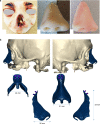Computational technology for nasal cartilage-related clinical research and application
- PMID: 32719336
- PMCID: PMC7385163
- DOI: 10.1038/s41368-020-00089-y
Computational technology for nasal cartilage-related clinical research and application
Abstract
Surgeons need to understand the effects of the nasal cartilage on facial morphology, the function of both soft tissues and hard tissues and nasal function when performing nasal surgery. In nasal cartilage-related surgery, the main goals for clinical research should include clarification of surgical goals, rationalization of surgical methods, precision and personalization of surgical design and preparation and improved convenience of doctor-patient communication. Computational technology has become an effective way to achieve these goals. Advances in three-dimensional (3D) imaging technology will promote nasal cartilage-related applications, including research on computational modelling technology, computational simulation technology, virtual surgery planning and 3D printing technology. These technologies are destined to revolutionize nasal surgery further. In this review, we summarize the advantages, latest findings and application progress of various computational technologies used in clinical nasal cartilage-related work and research. The application prospects of each technique are also discussed.
Conflict of interest statement
The authors declare no competing interests.
Figures








References
-
- Lavernia L, Brown WE, Wong BJF, Hu JC, Athanasiou KA. Toward tissue-engineering of nasal cartilages. Acta Biomater. 2019;88:42–56. - PubMed
-
- Pelttari K, Mumme M, Barbero A, Martin I. Nasal chondrocytes as a neural crest-derived cell source for regenerative medicine. Curr. Opin. Biotechnol. 2017;47:1–6. - PubMed
-
- Huang H, et al. Recapitulation of unilateral cleft lip nasal deformity on normal nasal structure: a finite element model analysis. J. Craniofac. Surg. 2018;29:2220–2225. - PubMed
Publication types
MeSH terms
LinkOut - more resources
Full Text Sources

